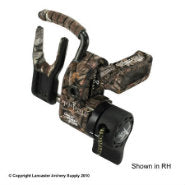You’ve got your first compound bow, and now you’re trying to figure out which arrow rest to put on it.
Looking through a catalog, you’ll undoubtedly notice many different rests in a variety of shapes and configurations.
Let us break them down for you so you can figure out which rest is right for your compound bow.
For starters, understand that a compound bow is meant to be shot using an arrow rest. Shooting off the shelf, like traditional recurve and longbow archers often do, really isn’t an option. When choosing an arrow rest for your bow, you should think about what you plan to do with your bow. Bowhunters, for example, have slightly different needs than target archers. A bowhunter has to consider all kinds of inclement weather and stalking through arrow-grabbing vegetation. The target archer, on the other hand, is only concerned about maximum accuracy.
When choosing an arrow rest for your bow, you should think about what you plan to do with your bow. Bowhunters, for example, have slightly different needs than target archers. A bowhunter has to consider all kinds of inclement weather and stalking through arrow-grabbing vegetation. The target archer, on the other hand, is only concerned about maximum accuracy.
Nearly all compound bow arrow rests on the market fall into one of the following basic categories:
1. Launcher Style – These rests have been around for a long time. Some feature a pair of prongs that support the arrow, while others have a single, thin blade. These rests support the arrow constantly through draw and release, until the arrow has left the bow. The prong rests once were the standard for bowhunters - and still are used by many today - while the blade rests have long been favorites among target archers. These rests are popular in both crowds because they are easy to set and have minimal contact with the arrow, which aids in consistency from shot to shot.
 2. Containment Style – The Whisker Biscuit is probably the best-known rest in this category, but there are others like it. These rests feature a full circle of nylon bristles, or up to three individual guides made of varying materials, that fully capture the arrow to hold it in place when the arrow is nocked. Once the arrow is captured, it’s very hard to knock it off the rest. Bowhunters love them because they’re simple, durable and nearly foolproof.
2. Containment Style – The Whisker Biscuit is probably the best-known rest in this category, but there are others like it. These rests feature a full circle of nylon bristles, or up to three individual guides made of varying materials, that fully capture the arrow to hold it in place when the arrow is nocked. Once the arrow is captured, it’s very hard to knock it off the rest. Bowhunters love them because they’re simple, durable and nearly foolproof.  3. Drop Away – Drop-away rests have become incredibly popular among both target archers and bowhunters over the past decade. As their name suggests, these rests support the arrow through the draw cycle, then drop out of the way during the shot. After the rest guides the first few inches of arrow upon string release, there is no more contact between arrow and rest after the rest falls away.
3. Drop Away – Drop-away rests have become incredibly popular among both target archers and bowhunters over the past decade. As their name suggests, these rests support the arrow through the draw cycle, then drop out of the way during the shot. After the rest guides the first few inches of arrow upon string release, there is no more contact between arrow and rest after the rest falls away.
Drop-aways come in three basic varieties. There are the limb-driven rests, where a cord is tied from the rest to one of the bow limbs. When the bow is at rest, the cord holds the rest flat against the shelf. As the archer draws and the limb flexes, the rest pops up to support the arrow at full draw. When the string is released, the cord pulls the rest out of the way of the arrow. Cable-driven rests employ a cord that’s tied to the down-moving cable on a compound. As the archer draws and the cable moves down, the cord pulls the rest up to support the arrow at full draw. When the string is released, the cord slides up and the rest drops down to the shelf.
Cable-driven rests employ a cord that’s tied to the down-moving cable on a compound. As the archer draws and the cable moves down, the cord pulls the rest up to support the arrow at full draw. When the string is released, the cord slides up and the rest drops down to the shelf. Both limb-driven and cable-driven rests allow the rest to move up and down as an archers draws and relaxes the bow.
Both limb-driven and cable-driven rests allow the rest to move up and down as an archers draws and relaxes the bow.
Inertia rests employ cords attached to the down cable, but the rests can be “cocked” in the upright position while the bow is at rest. This holds the arrow in place through the draw cycle. And if the archer lets down the bowstring, the rest will stay up. Only when the string is released, and there is a sudden release of energy by the bow, does the inertia rest fall out of the way. These rests are particularly favored by bowhunters, who can nock an arrow, cock the rest, and then not have to worry about the arrow falling off the rest.
These rests are particularly favored by bowhunters, who can nock an arrow, cock the rest, and then not have to worry about the arrow falling off the rest.

